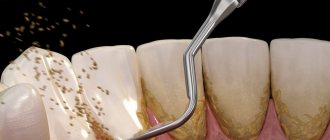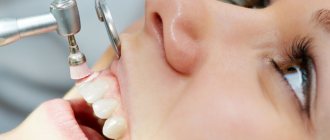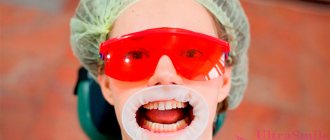22.11.2019
White plaque in the mouth is one of the signs of candidal stomatitis. This pathology is caused by the Candida fungus and most often affects young children. In addition to deposits, redness appears on the oral mucosa, which causes severe discomfort.
For what reasons does it appear?
White plaque in the mouth in adults occurs for the following reasons:
- development of endocrine pathologies;
- metabolic disorder;
- taking medications (antibiotics, hormonal drugs);
- vitamin deficiency;
- chronic infections of the nasopharynx and oral cavity;
- hepatitis (in particular hepatitis C).
Sometimes this symptom signals the development of cancer processes. In 10% of cases, intestinal cancer manifests itself this way.
What does it mean to have a whitish coating in your mouth in the morning?
In 80% of cases, this symptom is provoked by dry mucous membranes. This happens when a person sleeps with his mouth open - the appearance of deposits is due to a violation of natural hydration.
Another possible reason is impaired saliva production.
In women, this symptom occurs against the background of hormonal changes. Expectant mothers, as well as women in menopause, are at risk.
Appearance of yellowish deposits
A yellow coating appears in smokers, as well as in fans of black tea and coffee. If it is present in small quantities, there is no need to worry. If the deposits are poorly removed and are accompanied by additional symptoms, we may be talking about liver damage.
Possible reasons for the appearance of yellow deposits:
- gallstones;
- acute pancreatitis;
- cholecystitis;
- hepatitis.
A noticeable greenish tint may indicate stagnation of bile.
How to prevent plaque formation?
As you know, the best treatment for diseases is their prevention. To prevent unaesthetic plaque on your teeth from bothering you and making you suffer in the dentist’s chair, remember a few rules that will help keep your teeth white, strong and smooth:
- Give up bad habits. No matter how trivial it may sound, it is smoking and alcohol abuse that are the strongest enemies of enamel. Put out the cigarette once and for all, minimize the consumption of wine, beer, vodka and other strong drinks, and within a couple of months you will notice that the condition of your teeth has noticeably improved.
- Review your diet . Coffee, soda, sweet juice and black tea are not at all safe for your teeth, even if you drink them through a straw. And caramels, toffees, cakes and chocolates not only leave an unpleasant coating on the enamel, but also provoke tooth decay. Include more fresh fruits, vegetables, and herbs in your diet - these are the foods that allow you to cleanse crowns naturally; in addition, plants strengthen the body.
- Don't write off sugar-free candies and chewing gum . These products activate salivation.
- Remember the rules of personal hygiene . Brushing your teeth twice a day is the key to healthy enamel, crowns, gums and nerves. Choose your toothpaste carefully, brush every square millimeter, be mindful of the space between your teeth, and be sure to remove the film from your tongue.
Effective and safe teeth whitening and cleansing of surface enamel stains is provided by Asepta Plus gentle whitening toothpaste. This paste has a unique multi-stage teeth cleaning system that guarantees whitening for 4 weeks without damaging the tooth enamel. Hydroxyapatite and potassium citrate, which are part of the paste, mineralize weakened tooth enamel, prevent the occurrence of increased tooth sensitivity, and calamus and eleutherococcus extracts strengthen the gums and accelerate the regeneration processes of the oral mucosa.
Main manifestations
White plaque on the palate of an adult is accompanied by the following symptoms:
- feeling of itching and burning in the mouth;
- the appearance of small ulcers on the mucous membrane;
- hypersensitivity to temperature stimuli;
- feeling of a lump in the throat;
- hypersensitivity to mechanical irritation.
Mouth ulcers are bright pink or red in color. If the wounds become infected, profuse purulent discharge appears.
Primary symptoms
One of the first symptoms of candidal stomatitis is the appearance of dry mouth and white plaque. Deposits appear in the form of ragged or neat small spots.
This symptom is accompanied by severe discomfort, which is expressed in burning and itching of the affected areas.
As the disease progresses, a white coating appears on the inside of the cheeks. Next, the gums and tonsils are affected.
At the initial stage of the pathology, plaque can be easily removed with a cotton swab. Beneath it, painful red lesions are found.
Secondary manifestations
Additional signs include:
- increased sensitivity of the mucous membrane. Eating salty, spicy and sour foods causes pain;
- decreased sense of taste;
- the appearance of a specific metallic taste;
- bleeding ulcers;
- the appearance of mycotic lesions (the skin in the corners of the mouth becomes red, then becomes covered with microscopic cracks. Then a white coating appears in the corners of the lips);
- the occurrence of pain when swallowing saliva;
- an increase in general temperature (this is due to the body’s response to the pathogenic activity of fungi);
- unmotivated weakness, drowsiness;
- the appearance of bad breath;
- slowing down the rate of speech;
- enlargement of taste buds on the tongue.
The “spotty” coating on the sky gradually merges into a continuous white film. Its structure becomes denser and it becomes more difficult to remove.
What is plaque on teeth?
Unpleasant plaque is nothing more than a film-like accumulation of bacteria that forms on the teeth. Yes, such an accord creates an unpleasant color of the enamel, “gives” the owner bad breath and ultimately has a detrimental effect on the health of the teeth and gums.
The fact is that plaque is often caused by tartar, which negatively affects the enamel and also provokes inflammation of the gums.
Why does plaque form on teeth?
Typically, plaque formation is caused by several factors. The most common causes of black or yellow film on crowns are:
- Irregular, improper oral hygiene.
- Eating exclusively soft foods and avoiding fresh fruits and vegetables, which naturally remove plaque.
- Defects in tooth growth, malocclusion, and, as a result, difficulty in cleaning them.
- Negative effects due to taking certain medications.
- Periodontitis is an inflammation of the tissues surrounding the roots.
And, of course, those at particular risk for the appearance of black, yellow and brown plaque on the teeth are coffee and strong tea drinkers, smokers, as well as those who like to eat highly colored foods.
Establishing a diagnosis
If a plaque is detected on the palate of an adult’s mouth, the doctor undertakes:
- Listen to the patient's complaints.
- Collect anamnesis.
- Inspect the mucous membrane and skin.
- Make a microscopy of a scraping from the oral cavity.
Additionally, the patient may be referred for consultation:
- to a dermatologist - in order to identify fungal infections of other systems and organs;
- endocrinologist - to detect endocrine pathologies;
- an allergist - in order to determine the body’s sensitization to the materials from which dentures are made.
After clarification of the diagnosis, treatment is prescribed.
Features of therapy
Treatment involves the use of topical drugs and internal medication.
To treat the oral cavity in adults, with very high sensitivity of the mucous membrane, it is allowed to use a diluted Lugol's solution (2 tsp per 200 ml of warm water from a kettle).
You can also lubricate the oral cavity with baking soda diluted in water (1/2 tsp per 150 ml of warm boiled water). The procedure should be carried out 2-3 times a day.
Drug therapy involves the use of antifungal and painkillers. Antihistamines are additionally used as prescribed by an allergist.
Use of antifungal agents
The main antifungal drugs are presented in the table:
| A drug | Description | Mode of application | How to use |
| Ketocanazole, 200 mg | The main effects are antiandrogenic, antifungal, fungicidal, fungistatic. The drug helps inhibit the synthesis of ergosterol, triglycerides and phospholipids. Against this background, fungi lose their ability to form colonies and threads. | Oral | The daily norm is 1-2 tablets for 14 days. Then, after the disappearance of acute symptoms - 1 tablet 24 hours - until the white deposits and ulcers completely disappear. |
| Fluconazole, 50 mg | The main effect is antifungal. Has a highly specific effect. | Oral | 50-100 mg/24 hours, for 1-2 weeks, until the sensation of plaque in the mouth completely disappears. |
| Nystatin, 1% | Effects – antifungal, fungistatic. The presence of double bonds in the composition helps ensure high tropism of the antibacterial drug to the sterols of the fungal cell membrane. | Local impact | The oral cavity should be treated 2 times/24 hours until the white plaque and other symptoms disappear. The approximate duration of the course is 10 days. |
| Clotrimazole, 1% | The product belongs to the group of imidazole derivatives. Effects: antibacterial, antiprotozoal, trichomonacid, broad-spectrum antifungal. | Local impact | The oral cavity is treated 2 times/24 hours until the white plaque disappears. The average course duration is 7 days. |
| Chlorhexidine bigluconate, 0.05% | The main effect is antiseptic. | Local impact | Intended for the treatment of mouth ulcers. 3 times/24 hours, 7 days. |
If the oral cavity is covered with a white coating
Teeth, probably more than any other structure in our body, can cause a lot of trouble if not taken care of properly. This happens because they carry the beginnings of many diseases of the digestive system, and can also significantly reduce immunity, especially if they are constantly exposed to all kinds of inflammation. The importance of timely prevention of dental diseases is no longer disputed by anyone. The oral cavity is especially susceptible to many diseases. Among them, there are diseases with fairly similar symptoms, the main of which is the appearance of white plaque on the mucous membrane of the gums, cheeks and tongue.
We list the diseases associated with the appearance of white plaque in the oral cavity :
- pachydermia of the mouth; - leukoplakia; - white spongy nevus of Cannon; - Lichen planus; — candidiasis (thrush); - chemical burns.
Candiosis and leukoplakia, just like oral pachyderma and chemical burns, are localized in any part of the oral cavity. Lichen planus can also occur anywhere in the mouth, but most often appears on the surface of the mucous membrane of the cheeks. White spongy nevus of Cannon is localized only on the surface of the buccal mucosa.
Let's talk in more detail about the features of these diseases.
Thus, oral pachyderma is usually caused by the presence of a persistent irritant. The raised, white lesion is caused by hyperkeratosis, a thickening of the oral epithelium secondary to healthy mucosa. When the irritant is removed, healing occurs, lasting for two to three weeks.
If a white spot is found in the oral cavity, and sometimes a convex plaque with clearly defined edges, these are characteristic signs of leukoplakia. When this disease manifests itself in a more severe form, the designated area will become compacted and bumpy, and cracks and erosion may appear on it over time.
Smoking is most often to blame for the occurrence of leukoplakia. So smokers need to be more careful about caring for and maintaining order in their oral cavity. In addition, leukoplakia can appear due to thermal, chemical, and mechanical irritants. Leukoplakia is often a precancerous disease, since the most severe type of this lesion can develop cancer. Fortunately, diseases are almost always treatable. At the same time, the plaque that occurs during this disease, unlike the same candidiasis, is not removed by simple scraping.
Candidiasis, or thrush, is a greasy white patch that occurs in sick children, frail elderly people, and in patients receiving high doses of corticosteroids or broad-spectrum antibiotics, or those suffering from acquired immunodeficiency syndrome (AIDS). Candiosis responds well to antifungal therapy after eliminating predisposing factors.
Cannon's white spongy nevus most often affects the cheeks symmetrically and can be treated without much difficulty, as does lichen planus, the grayish-white papules of which can even disappear spontaneously.
Remember that only a firm hand and the experience of a specialist accumulated over time will effectively save you from such diseases. If you have similar symptoms or suspicions, do not try to self-medicate - contact your dentist. The Apollonia dental clinic, located next to the Chertanovskaya metro station, offers a wide range of dental services in the treatment of diseases of the teeth and gums, as well as providing services such as prosthetics, implantation, teeth whitening and much more. You can consult with specialists by calling the numbers listed in the “Contacts” section.
Use of painkillers
The table shows the most effective analgesics. They are prescribed only according to indications.
| A drug | Description | Mode of application | How to use |
| Lidocaine hydrochloride, 1% | A potent local anesthetic. Effects: antiarrhythmic, local anesthetic. | Local impact | Prescribed against the background of hypersensitivity to amide anesthetics. Used for applications, before meals. |
| Procaine, 5 mg/ml, 0.5% | Local anesthetic. | Local impact | In the form of applications before meals and treating the mouth with antifungal drugs. |










